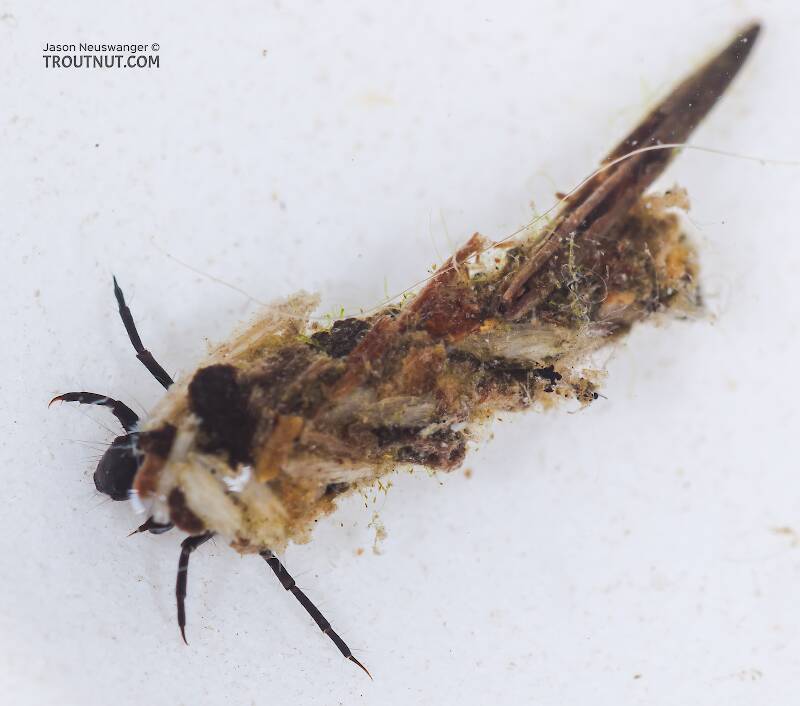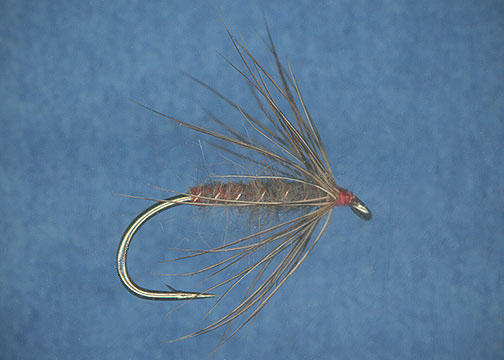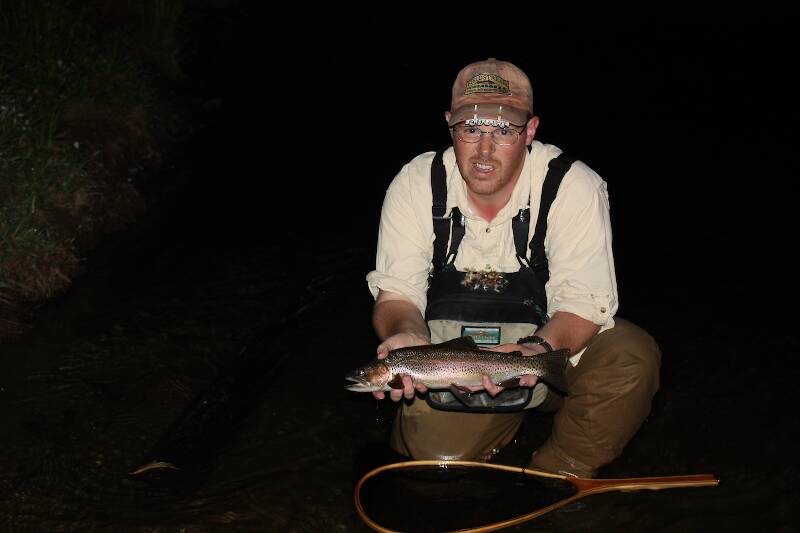
Salmonflies
Pteronarcys californica
The giant Salmonflies of the Western mountains are legendary for their proclivity to elicit consistent dry-fly action and ferocious strikes.
Featured on the forum

This seems to be a young larva of Limnephilus. Although not clear in the picture, several ventral abdominal segments have chloride epithelia.

Troutnut is a project started in 2003 by salmonid ecologist Jason "Troutnut" Neuswanger to help anglers and
fly tyers unabashedly embrace the entomological side of the sport. Learn more about Troutnut or
support the project for an enhanced experience here.
Patcrisci on Mar 21, 2010March 21st, 2010, 4:58 am EDT
I have been having a debate with myself as to which technique makes for a more effective and more durable dubbed body on flies. And, which technique -- the dubbing loop, or dubbing spun on thread -- do you use, is better suited, for dries, wets, nymphs?
By way of background, for newer tyers, in the spun dubbing method, dubbing material is twisted onto the working thread and the dubbed thread is wound forward to create the body of the fly. In the dubbing loop method you make a loop of thread on the shank of the hook and then place dubbing inside the thread loop. I grab the end of the loop with hackle pliers and twist it tight to form a rope of dubbing material which is caught between the twisted thread. Then I wind the working thread forward, then wind the dubbing loop forward to make the body.
The loop seems to work well for trapping a dubbing mix of soft and stiff, fur and hair. I've used short guard hairs of squirrel, rabbit, deer's mask hair, of course, seal fur, and even short pieces of clipped synthetic materials. The result is a fuzzy, buggy-looking fly.
By way of background, for newer tyers, in the spun dubbing method, dubbing material is twisted onto the working thread and the dubbed thread is wound forward to create the body of the fly. In the dubbing loop method you make a loop of thread on the shank of the hook and then place dubbing inside the thread loop. I grab the end of the loop with hackle pliers and twist it tight to form a rope of dubbing material which is caught between the twisted thread. Then I wind the working thread forward, then wind the dubbing loop forward to make the body.
The loop seems to work well for trapping a dubbing mix of soft and stiff, fur and hair. I've used short guard hairs of squirrel, rabbit, deer's mask hair, of course, seal fur, and even short pieces of clipped synthetic materials. The result is a fuzzy, buggy-looking fly.
Pat Crisci
Wiflyfisher on Mar 21, 2010March 21st, 2010, 5:58 am EDT
A soft hackle wet fly, or nymph, with the thorax section tied using a dubbing loop makes an extremely effective pattern.
John S.
https://WiFlyFisher.com
https://WiFlyFisher.com
JOHNW on Mar 21, 2010March 21st, 2010, 6:27 am EDT
Pat,
For Dries I almost exclusively use the direct dubbed "noodle" approach.
I find the dubbing loop to really shine in situations where I want to build up some bulk or want a really buggy look. So patterns like stoneflies (thorax portions), cress bugs, or wool head sculpins or the Shenks Minnow get the loop treatment.
JW
For Dries I almost exclusively use the direct dubbed "noodle" approach.
I find the dubbing loop to really shine in situations where I want to build up some bulk or want a really buggy look. So patterns like stoneflies (thorax portions), cress bugs, or wool head sculpins or the Shenks Minnow get the loop treatment.
JW
"old habits are hard to kill once you have gray in your beard" -Old Red Barn
Softhackle on Mar 21, 2010March 21st, 2010, 8:37 am EDT
Hi,
Well, I use a dubbing brush fabricated as Leisenring did. These are very effective for strong, well-tied bodies. Occasionally, I dub to the tying thread, but for wet flies & flymphs, the Leisenring method works best for me. While many feel a dubbing loop technique is the same, it's not, really. I believe the result of the Leisenring dubbing brush is rough, buggy, and more effective. I also find it easier to control the distribution of the dubbing along the tying thread better using this method.
Mark
Well, I use a dubbing brush fabricated as Leisenring did. These are very effective for strong, well-tied bodies. Occasionally, I dub to the tying thread, but for wet flies & flymphs, the Leisenring method works best for me. While many feel a dubbing loop technique is the same, it's not, really. I believe the result of the Leisenring dubbing brush is rough, buggy, and more effective. I also find it easier to control the distribution of the dubbing along the tying thread better using this method.
Mark
"I have the highest respect for the skilled wet-fly fisherman, as he has mastered an art of very great difficulty." Edward R. Hewitt
Flymphs, Soft-hackles and Spiders: http://www.troutnut.com/libstudio/FS&S/index.html
Flymphs, Soft-hackles and Spiders: http://www.troutnut.com/libstudio/FS&S/index.html
Patcrisci on Mar 21, 2010March 21st, 2010, 12:02 pm EDT
Mark, thanks. I've heard of a dubbing brush but never used one. I have used a dubbing needle to pick out fur/hair on nymph bodies. Would you be willing to expand a bit on the Leisenring method and Leisenring dubbing brush?
Pat Crisci
JAD on Mar 21, 2010March 21st, 2010, 12:47 pm EDT
Pat I like the DL for many reasons. Let your mind wonder and you will come up with some very different effects. If you dub very sparse and let the thread color show through,you can use two different color threads( with a knot) so you get a twisted effect,or you can put a little bit tinsel in lope -then twist or put some antron in lope or a feather----well you get the idea your options are endless. IMHO most tiers dub to heavy .
Best
JAD
Best
JAD
They fasten red (crimson red) wool around a hook, and fix onto the wool two feathers which grow under a cock’s wattles, and which in colour are like wax.
Radcliffe's Fishing from the Earliest Times,
Wbranch on Mar 21, 2010March 21st, 2010, 1:52 pm EDT
For many of the nymphs I tie I use a dubbing noodle for the abdomen and a dubbing loop for the thorax. A dubbing looped thorax is very impressionistic and there is no need for hackle or partridge "legs". I like this kind of fly especially for the Erie steelhead creeks because I want a fly that is quick to tie because I lose so many flies in the shale on the bottom but is still very effective.
Catskill fly fisher for fifty-five years.
Softhackle on Mar 21, 2010March 21st, 2010, 2:58 pm EDT
Hi Pat,
The dubbing "brush" is the result of the Leisenring method of dubbing. The brush is made off the fly and tied two the fly. Leisenring did the process of creating the "brush" on his pant-leg. Here is a link to the process:
http://www.troutnut.com/libstudio/Leisenring
Later, a dubbing block was created by one of Leisenring's students, Dick Clark. I'll see if I can locate a photo. There is a photo and explanation for use in Dave Hughes' book WET FLIES.
Again, I find the results are very good with this method and there is more control over the process. Another advantage is you can make the dubbing brushes up ahead of time, to be used, later.
Mark
The dubbing "brush" is the result of the Leisenring method of dubbing. The brush is made off the fly and tied two the fly. Leisenring did the process of creating the "brush" on his pant-leg. Here is a link to the process:
http://www.troutnut.com/libstudio/Leisenring
Later, a dubbing block was created by one of Leisenring's students, Dick Clark. I'll see if I can locate a photo. There is a photo and explanation for use in Dave Hughes' book WET FLIES.
Again, I find the results are very good with this method and there is more control over the process. Another advantage is you can make the dubbing brushes up ahead of time, to be used, later.
Mark
"I have the highest respect for the skilled wet-fly fisherman, as he has mastered an art of very great difficulty." Edward R. Hewitt
Flymphs, Soft-hackles and Spiders: http://www.troutnut.com/libstudio/FS&S/index.html
Flymphs, Soft-hackles and Spiders: http://www.troutnut.com/libstudio/FS&S/index.html
Patcrisci on Mar 22, 2010March 22nd, 2010, 9:09 am EDT
Mark, wow, this is pretty cool. I had no idea that this method of creating a dubbing "brush" existed. I have heard of Leisenring. Is it the same Big Jim Leisenring of the "Leisenring Lift?" Did Leisenring prefer to use the dubbing brush for all of his wet flies or just for certain patterns/specific applications? The descriptive name "Dubbing Brush" suggests that this method produces a stiff, bristly fly. I wonder if there are other tyers who are using it today?
Pat Crisci
JOHNW on Mar 22, 2010March 22nd, 2010, 12:08 pm EDT
Pat it is one and the same Liesenring. If I remember correctly he was from the Lehigh Valley area of PA and fished extensively in the Pocono and Catskill Regions and most notably on the Broadheads where there is a pool which caries his name. There is also a memorial plaque along the Little Lehigh to him (JAD can attest to that one).
JW
JW
"old habits are hard to kill once you have gray in your beard" -Old Red Barn
Wiflyfisher on Mar 22, 2010March 22nd, 2010, 1:25 pm EDT
Leisenring Dubbing Method is a great way to make a fuzzy body or thorax, but so can a dubbing loop work well if used properly. I find getting the right wax is key to holding the loose hair onto the thread before twisting. I use Leisenring/Keene Wax that I get from JimsFlyCo.com. This is the best wax I have ever used for fly tying.

The body of the above fly was created with hare's ear, Keene wax and a dubbing loop.
The body of the above fly was created with hare's ear, Keene wax and a dubbing loop.
John S.
https://WiFlyFisher.com
https://WiFlyFisher.com
Softhackle on Mar 22, 2010March 22nd, 2010, 2:19 pm EDT
Pat,
Yes, others do use the dubbing brush as Leisenring did. Jim would make up bodies like this and store them on cards that had slits cut into them on opposite sides. This way, he could make up bodies ahead of time to be used later. Big Jim used it for all his dubbed wet flies, and was quite a successful wet fly fisherman. He felt that the body construction was very important and that the tying thread should show through the dubbing, somewhat to give the overall effect of the insect.
The affect should look like this:

Another advantage is you can use different colored thread than the tying thread for the dubbing brush. Sure you can do this with a loop IF you tie on different colored thread. You still have to tie this on separately, so you might as well create the entire brush, then tie it on.
The wax that John (WiFlyFisher) is very good stuff for performing this dubbing application.
John,
I'm sure if you spoke with Jim, he'd tell you that dubbing as Leisenring did is not quite the same as dubbing in a dubbing loop. The results are slightly different.
Mark
Yes, others do use the dubbing brush as Leisenring did. Jim would make up bodies like this and store them on cards that had slits cut into them on opposite sides. This way, he could make up bodies ahead of time to be used later. Big Jim used it for all his dubbed wet flies, and was quite a successful wet fly fisherman. He felt that the body construction was very important and that the tying thread should show through the dubbing, somewhat to give the overall effect of the insect.
The affect should look like this:

Another advantage is you can use different colored thread than the tying thread for the dubbing brush. Sure you can do this with a loop IF you tie on different colored thread. You still have to tie this on separately, so you might as well create the entire brush, then tie it on.
The wax that John (WiFlyFisher) is very good stuff for performing this dubbing application.
John,
I'm sure if you spoke with Jim, he'd tell you that dubbing as Leisenring did is not quite the same as dubbing in a dubbing loop. The results are slightly different.
Mark
"I have the highest respect for the skilled wet-fly fisherman, as he has mastered an art of very great difficulty." Edward R. Hewitt
Flymphs, Soft-hackles and Spiders: http://www.troutnut.com/libstudio/FS&S/index.html
Flymphs, Soft-hackles and Spiders: http://www.troutnut.com/libstudio/FS&S/index.html
Wiflyfisher on Mar 22, 2010March 22nd, 2010, 2:31 pm EDT
John,
I'm sure if you spoke with Jim, he'd tell you that dubbing as Leisenring did is not quite the same as dubbing in a dubbing loop. The results are slightly different.
Mark
Jim is working very hard to convert me over to his ways. He is both a hackle nerd and a flymph junkie, as you already know. Being a cheeshead, I am just a slow learner.
BTW, Mark ties some of the best looking soft hackles I have ever seen.
John S.
https://WiFlyFisher.com
https://WiFlyFisher.com
Patcrisci on Mar 23, 2010March 23rd, 2010, 8:03 am EDT
Mark, nice soft hackled fly -- and I see the effect of using the gray dubbing on claret thread. It's a nice effect. I prefer to tie wet flies and nymphs that have bodies of rough dubbed fur and hair. I like to achieve a spiky, fuzzy look that I think imitates the movement of a live struggling or emerging insect and because I think this sort of dubbed body traps air and water that creates a flash and sparkle, as if to suggest a living creature. I have often picked up a nymph after fishing out a cast and looking at it noticed, for lack of a better word, a "halo-like" effect where water/trapped air beads up in a silvery bubble. Has anyone else noticed this? I suspect that the dubbing mixture (spiky mix of hair/fur, stiff/soft, and method of application (dubbing loop) produce this result. And John, that is exactly what I'm talking about. Your "hare's ear wax" fly looks killing!
Pat Crisci
Wiflyfisher on Mar 23, 2010March 23rd, 2010, 12:33 pm EDT
Pat,
Remember this... we fly fishing humans have been studying trout for centuries. Trout have a very, very small brain and yet they are still able to out smart us. At the same time, some of my worst tied flies catch more trout better than my best looking flies. My conclusion is... It is easier to catch other fly fishers than it is a wily trout. :)
Remember this... we fly fishing humans have been studying trout for centuries. Trout have a very, very small brain and yet they are still able to out smart us. At the same time, some of my worst tied flies catch more trout better than my best looking flies. My conclusion is... It is easier to catch other fly fishers than it is a wily trout. :)
John S.
https://WiFlyFisher.com
https://WiFlyFisher.com
Softhackle on Mar 23, 2010March 23rd, 2010, 2:28 pm EDT
Pat,
Your statement about trapping air in the dubbed bodies of flymphs is something Vern Hidy talked about years ago. Being a student/friend of Leisenring, he use to dry the flymph between casts to make it trap air. He called it a "hydrofuge". Vern also tied his flymphs on up-eye hooks. He said they looked better when drawing them up through the water column.
After talking about the air bubble, here on this board, and with the article Lloyd posted, I guess Hidy was right, and the practice makes sense.
Mark
Your statement about trapping air in the dubbed bodies of flymphs is something Vern Hidy talked about years ago. Being a student/friend of Leisenring, he use to dry the flymph between casts to make it trap air. He called it a "hydrofuge". Vern also tied his flymphs on up-eye hooks. He said they looked better when drawing them up through the water column.
After talking about the air bubble, here on this board, and with the article Lloyd posted, I guess Hidy was right, and the practice makes sense.
Mark
"I have the highest respect for the skilled wet-fly fisherman, as he has mastered an art of very great difficulty." Edward R. Hewitt
Flymphs, Soft-hackles and Spiders: http://www.troutnut.com/libstudio/FS&S/index.html
Flymphs, Soft-hackles and Spiders: http://www.troutnut.com/libstudio/FS&S/index.html
Wiflyfisher on Mar 23, 2010March 23rd, 2010, 2:49 pm EDT
Vern also tied his flymphs on up-eye hooks. He said they looked better when drawing them up through the water column.
Even though I have tied a lot of wet flies with turned down eyes, I have never really understood why. If I had a weight ahead of the fly then maybe a turned down eye would make more sense. The weight would sink below the eye and the turned down eye would be pointed in that direction.
This summer I plan on going below the surface of the stream for the first time and try to see my flies from a different perspective. Wish me luck. :)
John S.
https://WiFlyFisher.com
https://WiFlyFisher.com
Sayfu
Posts: 560
Posts: 560
Sayfu on Nov 2, 2011November 2nd, 2011, 8:15 am EDT
Didn't read all of the posts, but do we know which way to dub on the thread to create the tightest body when dubbing forward?...counter?..or clockwise twisted on the thread?
Entoman on Nov 2, 2011November 2nd, 2011, 9:19 am EDT
Yes, but it depends on the direction you tie and with which hand.
"It's not that I find fishing so important, it's just that I find all other endeavors of Man equally unimportant... And not nearly as much fun!" Robert Traver, Anatomy of a Fisherman
Quick Reply
Related Discussions
Topic
Replies
Last Reply
0
Jan 27, 2017
by Mcflyangler
by Mcflyangler
19
Apr 10, 2015
by TKB
by TKB







